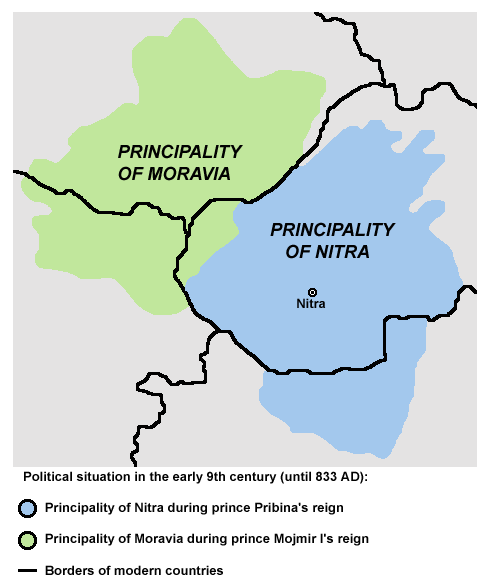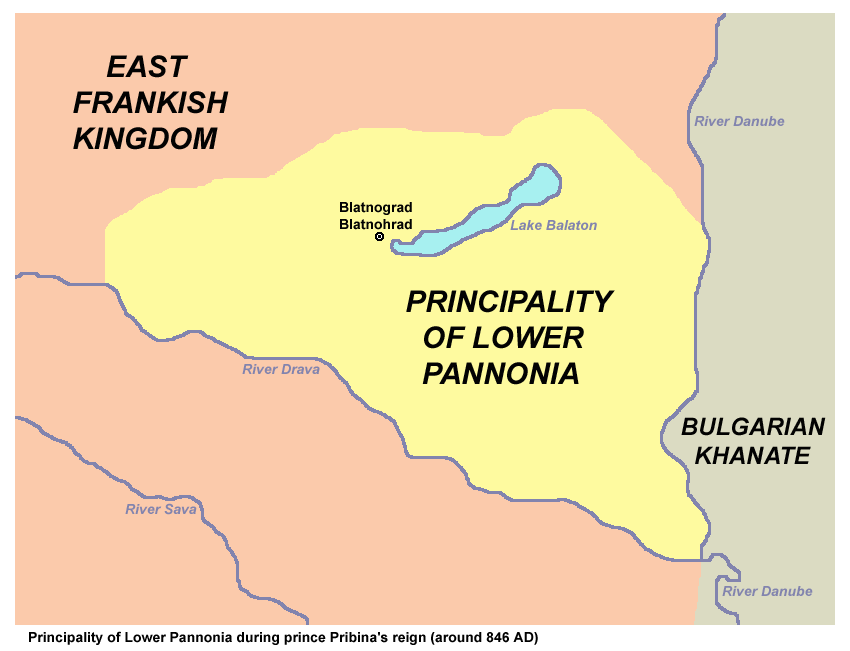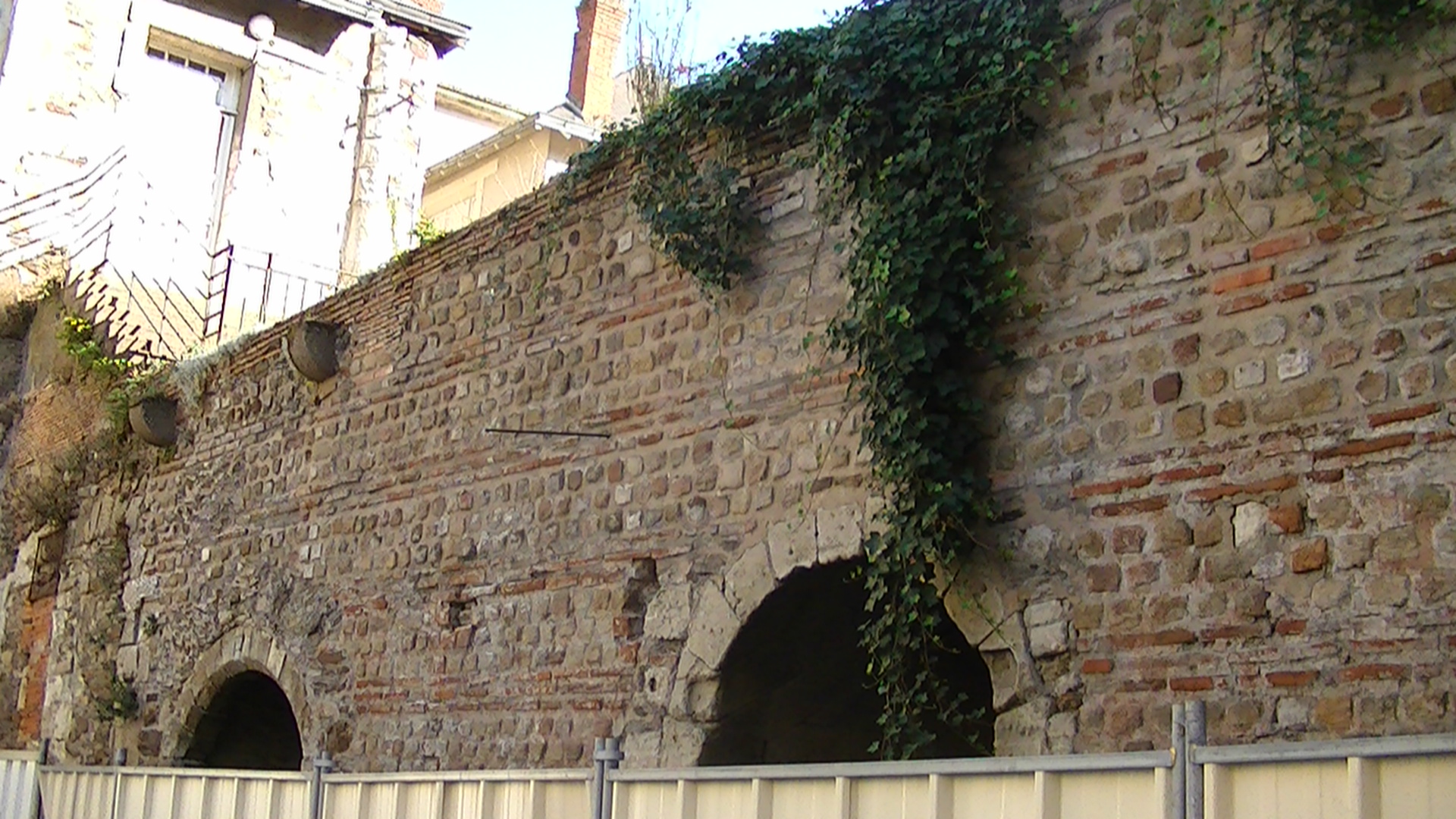|
846
__NOTOC__ Year 846 ( DCCCXLVI) was a common year starting on Friday of the Julian calendar. Events By place Byzantine Empire * Byzantine–Bulgarian War: The Bulgarians violate the peace treaty (see 815), and invade Macedonia along the River Struma. The cities of Serres and Philippi are devastated. Europe * Summer – Breton forces under Nominoe occupy the Frankish cities of Nantes and Rennes. He makes raids in Anjou and threatens Bayeux. King Charles the Bald recognizes him as duke of Brittany. * Prince Pribina becomes a vassal of the Frankish Empire. King Louis the German grants him land near Lake Balaton (modern Hungary). He establishes Blatnohrad, capital of Balaton Principality. * Frankish forces led by Louis the German invade Moravia. They encounter little resistance, and depose King Mojmir I from the throne.. His relative, Rastislav, is set up as the new client ruler. * Muslim forces attempt to raid Rome but only pillage the countryside around ... [...More Info...] [...Related Items...] OR: [Wikipedia] [Google] [Baidu] |
Mojmir I Of Moravia
Mojmir I, Moimir I or Moymir I (Latin: ''Moimarus'', ''Moymarus''; Czech and Slovak: ''Mojmír I.'') was the first known ruler of the Moravian Slavs (820s/830s–846) and eponym of the House of Mojmir. In modern scholarship, the creation of the early medieval state known as Great Moravia is attributed either to his or to his successors' expansionist policy. He was deposed in 846 by Louis the German, king of East Francia. The fate of Mojmir I after his deposal in 846 remains unclear. Background From the 570s the Avars dominated the large area stretching from the Eastern Carpathians to the Eastern Alps in Central Europe. The local Slavic tribes were obliged to pay tribute to their overlords, but they began to resist in the early 7th century.Spiesz ''et al.'' 2006, p. 17. First those who inhabited the region of today's Vienna (Austria) threw off the yoke of the Avars in 623–624. They were led by a Frankish merchant named Samo whose reign would last for at leas ... [...More Info...] [...Related Items...] OR: [Wikipedia] [Google] [Baidu] |
Rastislav Of Moravia
Rastislav or Rostislav (; ) was the second known ruler of Moravia (846–870).Spiesz ''et al.'' 2006, p. 20. Although he started his reign as vassal to Louis the German, the king of East Francia, he consolidated his rule to the extent that after 855 he was able to repel a series of Frankish attacks. Upon his initiative, brothers Cyril and Methodius, sent by the Byzantine Emperor Michael III in 863, translated the most important Christian liturgical books into Slavonic. Rastislav was dethroned by his nephew Svatopluk I of Moravia, who handed him over to the Franks. He was canonized by the Eastern Orthodox Church in 1994 and is also known as Saint Rastislav. Early life According to the '' Annals of Fulda'', Rastislav was a nephew of Mojmir I, the first known ruler of Moravia. His career before 846 is unknown,The Slovakian historian Stanislav J. Kirschbaum refers to Rastislav as prince of Nitra in the period before 846 (Kirschbaum 2005, p. 26.; Kirschbaum 2007, pp. x ... [...More Info...] [...Related Items...] OR: [Wikipedia] [Google] [Baidu] |
Great Moravia
Great Moravia (; , ''Meghálī Moravía''; ; ; , ), or simply Moravia, was the first major state that was predominantly West Slavic to emerge in the area of Central Europe, possibly including territories which are today part of the Czech Republic, Slovakia, Hungary, Austria, Germany, Poland, Romania, Croatia, Serbia, Ukraine and Slovenia. The formations preceding it in these territories were Samo's tribal union (631–658) and the Pannonian Avar state (567 – after 822). Its core territory is the region now called Moravia in the eastern part of the Czech Republic alongside the Morava River, which gave its name to the kingdom. The kingdom saw the rise of the first ever Slavic literary culture in the Old Church Slavonic language as well as the expansion of Christianity, first via missionaries from East Francia, and later after the arrival of Saints Cyril and Methodius in 863 and the creation of the Glagolitic alphabet, the first alphabet dedicated to a Slavic language. Glagol ... [...More Info...] [...Related Items...] OR: [Wikipedia] [Google] [Baidu] |
Pribina
Pribina (c. 800861) was a Slavs, Slavic prince whose adventurous career, recorded in the ''Conversio Bagoariorum et Carantanorum, Conversion of the Bavarians and the Carantanians'' (a historical work written in 870), illustrates the political volatility of the Franco–Slavic frontiers of his time. Pribina was the first ruler of Slavic origin to build a Christianity, Christian church on Slavic territory in Principality of Nitra, Nitra, and also the first to accept baptism. He was attacked and expelled from his homeland by Mojmir I of Moravia, Mojmir I, duke of Moravia. Pribina first fled to Radbod (prefect), Ratpot, one of the border lords in East Francia. Thereafter he was wandering in Central Europe, Central and Southeastern Europe for several years. Finally, in the late 830s, Louis the German, king of East Francia granted Pribina lands near Lake Balaton (now in Hungary) where he set up his own principality under the king's suzerainty. He died fighting against the Great M ... [...More Info...] [...Related Items...] OR: [Wikipedia] [Google] [Baidu] |
Nominoe
Nominoe or Nomenoe (; ; 763, 7 March 851) was the first Duke of Brittany from 846 to his death. He is the Bretons, Breton ''pater patriae'' and to Breton nationalism, Breton nationalists he is known as ' ("father of the country"). Origins He was the second son of Count Erispoe or Erispoë of Poher, King of the Browaroch (775–812), and younger brother of Count Riwallon or Rivallon III of Poher (?–857). Rise and titulature under Louis the Pious After a general rebellion which had enveloped the entire Carolingian Empire was put down, a general assembly was held at Ingelheim in May 831. It was probably there that the emperor Louis the Pious appointed Nominoe, a Breton, to rule the Bretons (which corresponded to "almost all" of Brittany). Regino of Prüm in his famous ''Chronicon'' writes, inaccurately for the year 837, that: '. Morman, king of the Bretons, died and Numenoi [Nominoe] was created duke of that same people by the emperor at Ingelheim. Nominoe ... [...More Info...] [...Related Items...] OR: [Wikipedia] [Google] [Baidu] |
Hungary
Hungary is a landlocked country in Central Europe. Spanning much of the Pannonian Basin, Carpathian Basin, it is bordered by Slovakia to the north, Ukraine to the northeast, Romania to the east and southeast, Serbia to the south, Croatia and Slovenia to the southwest, and Austria to the west. Hungary lies within the drainage basin of the Danube, Danube River and is dominated by great lowland plains. It has a population of 9.6 million, consisting mostly of ethnic Hungarians, Hungarians (Magyars) and a significant Romani people in Hungary, Romani minority. Hungarian language, Hungarian is the Languages of Hungary, official language, and among Languages of Europe, the few in Europe outside the Indo-European languages, Indo-European family. Budapest is the country's capital and List of cities and towns of Hungary, largest city, and the dominant cultural and economic centre. Prior to the foundation of the Hungarian state, various peoples settled in the territory of present-day Hun ... [...More Info...] [...Related Items...] OR: [Wikipedia] [Google] [Baidu] |
Throne
A throne is the seat of state of a potentate or dignitary, especially the seat occupied by a sovereign (or viceroy A viceroy () is an official who reigns over a polity in the name of and as the representative of the monarch of the territory. The term derives from the Latin prefix ''vice-'', meaning "in the place of" and the Anglo-Norman ''roy'' (Old Frenc ...) on state occasions; or the seat occupied by a pope or bishop on ceremonial occasions. "Throne" in an abstract sense can also refer to the monarchy itself, an instance of metonymy, and is also used in many expressions such as "power behind the throne, the power behind the throne". A throne is a symbol of divine and secular rule and the establishment of a throne as a defining sign of the claim to power and authority. It can be with a high backrest and feature heraldic animals or other decorations as adornment and as a sign of power and strength. A throne can be placed underneath a canopy or baldachin. The throne can s ... [...More Info...] [...Related Items...] OR: [Wikipedia] [Google] [Baidu] |
Principality Of Lower Pannonia
Early Slavs settled in the eastern and southern parts of the former Roman province of Pannonia. The term ''Lower Pannonia'', was used to designate those areas of the Pannonian Plain that lie to the east and south of the river Rába, with the division into ''Upper'' and ''Lower'' inherited from the Roman terminology. From the middle of the 6th to the end of the 8th century, the region was under the domination of the Avars, while the Slavic inhabitants lived under Avar rule. By the beginning of the 9th century, after Avar Wars, that state was destroyed and replaced by the supreme rule of the Frankish Empire, which lasted until the Magyar conquest (c. 900). During the Frankish period, the region of Lower Pannonia was governed by local Slavic rulers, who were under the suzerainty of Frankish kings. Within the Frankish administrative system, the March of Pannonia was created, with direct Frankish rule exercised in ''Upper Pannonia'' through Frankish counts, while ''Lower Pan ... [...More Info...] [...Related Items...] OR: [Wikipedia] [Google] [Baidu] |
Zalavár
Zalavár is a village in south-western Hungary, located in Zala County. It is located around southwest of Lake Balaton. Name According to written sources the settlement was called 'Mosapurc' in the 9th century, "''Mosapurc regia civitate''". It was also known as ''Moosburg'', ''Urbs Paludarum'', ''Braslavespurch'' and ''Blatengrad'' in medieval records. The medieval settlement is known in modern sources as ''Blatnohrad'' ( Slovak), ''Blatnograd'', Блатноград (Serbo-Croatian and Bulgarian). Ján Kollár called it ''Salavár'' in his travel book and described the state of the ruins in 1841. History In the 9th century, ''Mosapurc'' or ''Moosburg'' was a fortified settlement built along the Zala river and was the capital of the Frankish vassal Lower Pannonian Principality ruled by a Slavic prince Pribina (''"Privinae civitas, munimen, castrum in nemore et palude Salae"'' in a Salzburg chronicle). During the reign of Pribina's son, prince Kocel (861–876), in the sum ... [...More Info...] [...Related Items...] OR: [Wikipedia] [Google] [Baidu] |
Balaton Principality
Early Slavs settled in the eastern and southern parts of the former Roman province of Pannonia. The term ''Lower Pannonia'', was used to designate those areas of the Pannonian Plain that lie to the east and south of the river Rába, with the division into ''Upper'' and ''Lower'' inherited from the Roman terminology. From the middle of the 6th to the end of the 8th century, the region was under the domination of the Avars, while the Slavic inhabitants lived under Avar rule. By the beginning of the 9th century, after Avar Wars, that state was destroyed and replaced by the supreme rule of the Frankish Empire, which lasted until the Magyar conquest (c. 900). During the Frankish period, the region of Lower Pannonia was governed by local Slavic rulers, who were under the suzerainty of Frankish kings. Within the Frankish administrative system, the March of Pannonia was created, with direct Frankish rule exercised in ''Upper Pannonia'' through Frankish counts, while ''Lower Pannon ... [...More Info...] [...Related Items...] OR: [Wikipedia] [Google] [Baidu] |
Nantes
Nantes (, ; ; or ; ) is a city in the Loire-Atlantique department of France on the Loire, from the Atlantic Ocean, Atlantic coast. The city is the List of communes in France with over 20,000 inhabitants, sixth largest in France, with a population of 320,732 in Nantes proper and a metropolitan area of nearly 1 million inhabitants (2020). With Saint-Nazaire, a seaport on the Loire estuary, Nantes forms one of the main north-western French metropolitan agglomerations. It is the administrative seat of the Loire-Atlantique Departments of France, department and the Pays de la Loire Regions of France, region, one of 18 regions of France. Nantes belongs historically and culturally to Brittany, a former Duchy of Brittany, duchy and Province of Brittany, province, and Reunification of Brittany, its omission from the modern administrative region of Brittany is controversial. Nantes was identified during classical antiquity as a port on the Loire. It was the seat of a bishopric at the ... [...More Info...] [...Related Items...] OR: [Wikipedia] [Google] [Baidu] |
Bayeux
Bayeux (, ; ) is a commune in the Calvados department in Normandy in northwestern France. Bayeux is the home of the Bayeux Tapestry, which depicts the events leading up to the Norman Conquest of England in 1066. It is also known as the first major town secured by the Allies during Operation Overlord after D-Day. Charles de Gaulle made two famous speeches in this town. Administration Bayeux is a sub-prefecture of Calvados. It is the seat of the arrondissement of Bayeux and of the canton of Bayeux. Geography Bayeux is located from the coast of the English Channel and north-west of Caen. The city, with elevations varying from above sea level – with an average of – is bisected by the River Aure. Bayeux is located at the crossroads of RN 13 and the train route Paris-Caen-Cherbourg. The city is the capital of the Bessin, which extends north-west of Calvados. Bayeux station has rail connections to Caen, Cherbourg, Granville and Paris. The river Aure flows throug ... [...More Info...] [...Related Items...] OR: [Wikipedia] [Google] [Baidu] |








